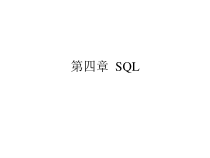 PPT
PPT
【文档说明】分布式数据库sql语句课件.ppt,共(64)页,136.512 KB,由小橙橙上传
转载请保留链接:https://www.ichengzhen.cn/view-92354.html
以下为本文档部分文字说明:
第四章SQL引言•IBMSYSTEMRSEQUEL•ANSI标准SQL1990•ISO标准SQL1992•SQL3(SQL99)体系结构•View•Table•FileSQL•DDL包括完整性与安全性•DMLSQLDDL•需要创建的结构–Tab
le–View–IndexCreate{table,view,index}<name><descriptionforthat>E.g.CreateTableDEPT(DEPT#Number,DNAMEChar(5),BudgetNumber(7,2));SQLDDL–
续•索引Createindex<name>on<tablename>(<indexattrnamelist>)E.g.CreateindexI1onEMP(E#);CreateindexI2onEMP(E
name);•唯一性索引E.g.CreateuniqueindexI1onEMP(E#);SQLDDL–续•聚集索引元组按照索引值顺序,物理上尽可能的存储在一起,在索引值上执行扫描(scan)操作时可以
减少I/O.E.g.CreateclusterindexCI1onEMP(E#);基本查询块•典型的SQL查询语句格式:selectA1,A2,...,Anfromr1,r2,...,rmwhereP–Ais代表属性–ris代表关系–P
是谓词.Select子句•select短语用于列出所有要查询的结果属性.•例如查找DEPT关系中所有部门名字selectdnamefromDEPT•注意:SQL大小写无关Select子句-续•SQL的查询
结果中允许有重复.•使用distinct消重复.•例如:查找DEPT关系中所有不同名的部门名字selectdistinctdnamefromDEPTSelect子句-续•select短语中可以包含数学表达式.•例如:selectS#,Sname,Status2fromS.Wher
e子句•where短语由给出谓词,其谓词由出现在from短语中的关系的属性组成.•查找所有居住在London并且状态大于20的供应商的供应商号selectS#fromSwherecity=‘London’ANDstatus>
20•比较操作结果可以用逻辑操作and,or,和not相连.Where子句-续•between比较操作.•查找状态在20和30之间的供应商的商号(也就是说要,20并且30)selectS#fromSwherestatusbetween20and3
0From子句•from短语列出的关系在执行时要被扫描.•查找employee×department的结果selectfromEMP,DEPTwhereemp.D#=dept.D#重命名操作•SQL使
用别名(aliasname)对关系和属性重命名:old-namenew-name•查找所有供应商的名字、商号和状态;将S#重命名为number、将sname重命名为nameselectsnamename,s#number,statusfromS元组变量•from短语
使用别名定义元组变量.•查找所有已供应零件的供应商名字和零件号.selectsx.sname,spx.P#fromSsx,SPSpxwheresx.S#=spx.s#串操作•SQL含有串匹配操作.末拌有两个特殊的符号描述:–%.代表任意长的子串.–_.代表任意的单字符.•Findt
henamesofallsupplierswhosecitynameincludesthesubstring“Main”.selectsnamefromswherecitylike‘%Main%’串操作-续•SQL包括其他串操作例如–
concatenation(using“||”)–convertingfromuppertolowercase(andviceversa)–findingstringlength,extractingsubstrings,etc.排序•Listinalphabetic
orderthenamesofallsupplierslocatinginLondoncityselectdistinctsnamefromSwherecity=„London’orderbysname•desc表示降序,asc表示升序;缺省时升序–
E.g.orderbysnamedesc集合操作•union,intersect,和except•集合操作自动消重复集合操作-续•Findallcitieswherehaveasupplier,apart,orboth:(selectcityfrom
S)union(selectcityfromP)•Findallcitieswherehavebothasupplierandapart.(selectcityfromS)intersect(selectcityfromP)•Findallcitieswherehaveasupplierbu
tnoP.(selectcityfromS)except(selectcityfromP)聚集函数•avg•min•max•sum•count聚集函数-续•FindtheaverageQTYthatissuppliedbysu
ppliers1.selectavg(QTY)fromSPwheres#=„s1‟•Findthenumberoftuplesinthesupplierrelation.selectcount(*)fromS•Findthenumberofsup
plierswhosupplypart.selectcount(distincts#)fromSP聚集函数-续•Findthenumberofpartforeachsupplier.selectsname,count(disti
nctp#)fromS,SPwhereS.s#=SP.s#groupbysname注意:select短语中出现在聚集函数外面的属性必须要在groupby列表中聚集函数-续•Findthenumberofallsupplierswhoha
vesuppliedpartmorethan600.selects#,avg(QTY)fromSPgroupbys#havingavg(QTY)>600聚集函数-续•Note:having短语和where短语的不
同处selectd#,avg(SAL)fromEMPwhereage<40groupbyd#havingavg(SAL)>600空值•元组的某些属性有可能取空值,记为null•null表示一个未知的值或者表示一个
不存在的值.•任何涉及null的算术运算的结果是null–E.g.5+nullreturnsnull•聚集函数计算中将忽略空值空值-续•isnull谓词用于判断空值.–E.g.FindallEmployeenumberwhichappe
arintheEMPrelationwithnullvaluesford#.selectE#fromEMPwhered#isnull•任何与null的比较运算结果是unknown–E.g.5<nullornull<>nullornull=null空值-续•Totalallp
artquantityselectsum(QTY)fromSP–上述语句忽略空值QTY–如果没有非空的QTY,结果是null•除了count(*),所有聚集函数计算都忽略nullvalues.嵌套子查询•SQLprovidesa
mechanismforthenestingofsubqueries.•Asubqueryisaselect-from-whereexpressionthatisnestedwithinanotherquery.•Acommonuseofsubqueriesistope
rformtestsforsetmembership,setcomparisons,andsetcardinality.举例•Findallemployeeswhohaveworkedinsalesdepartment.selectdistin
ctEnamefromEMPwhered#in(selectd#fromDEPTwhereDname=„sale‟)集合比较•Findallemployeeswhosesalarygreaterthansomemanager‟ssalary.selectEn
amefromEMPwheresal>some(selectsalfromEMPwhereE#in(selectmgrfromDEPT))集合比较-续•Findthenamesofallemployeeswhosesalarygreaterthanallmanager‟ss
alary.selectEnamefromEMPwheresal>all(selectsalfromEMPwhereE#in(selectmgrfromDEPT))集合比较-续•Definitionofsetcomparison•F<comp>somert
rs.t.(F<comp>t)•F<comp>allrtr(F<comp>t)Where<comp>canbe:集合比较-续056(5<some)=true050)=false505(5some)=true(since0
5)(read:5<sometupleintherelation)(5<some)=true(5=some(=some)inHowever,(some)notin集合比较-续056(5<all)=false6104)=true546(5all)=true(since54and5
6)(5<all)=false(5=all(all)notinHowever,(=all)in测试空关系•Theexistsconstructreturnsthevaluetrueiftheargumentsubqueryisnonempty.•existsrrØ•not
existsrr=Ø•NotethatX–Y=ØXY举例•FindallsupplierswhohavesuppliedallpartslocatedinLondon.selectdistinctSx.snamefromSS
xwherenotexists((selectpnamefromPwherecity=„London‟)except(selectPx.pnamefromSPTx,PPxwhereTx.p#=Px.p#
andSx.S#=Tx.s#))•Note:Cannotwritethisqueryusing=allanditsvariants唯一元组测试•Theuniqueconstructtestswhetherasubqueryhasanyduplicate
tuplesinitsresult.•Findallsupplierswhoareatmostonedepartmentmanager.selectT.EnamefromEMPTwhereunique(selectR.DnamefromDEPTRwhereT.e#=R
.MGR)•Findalldepartmentswhichhaveatleasttwoemployeeswhosesalarygraterthan$5000.selectdistinctT.Dnamefr
omDEPTTwherenotunique(selectR.EnamefromEMPRwhereT.d#=R.d#andR.SAL>=5000)删除•DeleteallsupplierswhoareinLondondeletefromSwherecit
y=‘London’•Deleteallsupplierswhosupplypartp2.deletefromSwheres#in(selects#fromSPwherep#=‘p2’)Note:Herehassomeproblemwithconstraintsthatwillexpla
inedinChapter8•Deletetherecordofallemployeeswithsalarybelowtheaverage.deletefromEMPwhereSAL<(selectavg(SAL)fromEMP)–Problem:aswedeletetuplesfr
omEMP,theaveragesalarychanges–SolutionusedinSQL:1.First,computeavgsalaryandfindalltuplestodelete2.Next,del
etealltuplesfoundabove(withoutrecomputingavgorretestingthetuples)插入•AddanewtupletoSinsertintoSvalues
(„s6‟,„wangping‟,20,„shanghai)orequivalentlyinsertintoS(status,city,s#,sname)values(20,„shanghai‟,„s6‟,„
wangping‟,)•AddanewtupletoSwithcitysettonullinsertintoSvalues(„s7‟,„Lihong‟,30,null)插入-续•ProvideasagiftforallloancustomersofthePer
ryridgebranch,a$200savingsaccount.insertintoaccountselectloan-number,branch-name,200fromloanwherebranch-name=„Perryridge‟•Theselectfromwherestatement
isfullyevaluatedbeforeanyofitsresultsareinsertedintotherelation(otherwisequerieslikeinsertintotable1select*fromtable1wouldcauseproblems)更新•Increase
allemployeeswithsalaryover$4,000by6%,allotheremployeesreceive5%.–Writetwoupdatestatements:updateEMPsetSAL=SAL1.06whereSAL>4
000updateEMPsetSAL=SAL1.05whereSAL4000–Theorderisimportant更多举例•Findallemployeeswhohavethelowestsalaryineachdepartment.SelectEname,d#,SALFr
omEMPWhereSALin(Selectmin(SAL)FromEMPGroupByd#)Note:Abovestatementhaserror,thecorrectis:SelectEname,d#,SALFromEMP
Where(d#,SAL)in(Selectd#,min(SAL)FromEMPGroupByd#)更多举例-续•FindallpartnumberanditstotalquantitySelectp#,sum(QTY)totqtyFromSPGroupByp#;oreq
uivalentlySelectp#,(Selectsum(QTY)FromSPWhereSP.p#=P.p#)totqtyFromP;嵌入SQL•TheSQLstandarddefinesembeddingsofSQLina
varietyofprogramminglanguagessuchasPascal,PL/I,Fortran,C,andCobol.•AlanguagetowhichSQLqueriesareembeddedisreferredtoasaho
stlanguage,andtheSQLstructurespermittedinthehostlanguagecompriseembeddedSQL.嵌入SQL-续•Thebasicformoftheselang
uagesfollowsthatoftheSystemRembeddingofSQLintoPL/I.•EXECSQLstatementisusedtoidentifyembeddedSQLrequesttothepreprocessorEXECSQL<embedded
SQLstatement>Note:thisvariesbylanguage.E.g.theJavaembeddinguses#SQL{….};嵌入SQL-续•QuerysingletupleEXECSQLSelectEnameINTO:enameFromEMPWh
eree#=„e1‟•QuerysettuplesTherearedismachedproblembetweenhostlanguagewithsub-language,usingmiddlerelationtosolvethisquestion.Note:“:e
name”calledhostvariablewhichneeddeclaredbyspecialstatement.嵌入SQL-续EXECSQLBEGINDECLARESECTION;CharSQLSTATE[6];CharP#[6];intWeigh
t;EXECSQLENDDECLARESECTION;P#=‘P2;EXECSQLSelectP.weightINTO:weightFROMPWHEREP.P#=:P#;IfSQLSTATE=‘00000’Then….Else…..;嵌入SQL-续•Thestatemen
tforSQLSTATE–EXECSQLWHENEVER<condition><action>•Conditon–Notfoundnodatawasfound‘02000’–Sqlerroranerroroccurr
ed举例•SpecifythequeryinSQLanddeclareacursorforitEXECSQLdeclareccursorforselectsname,cityfromS,SPwhereS.s#=SP.s#andSP.QTY
>:amountFromwithinahostlanguage,findthenamesandcitiesofsupplierssupplymorethanthevariableamountquantitypart.嵌入
SQL-续•TheopenstatementcausesthequerytobeevaluatedEXECSQLopencThefetchstatementcausesthevaluesofonetupleinthequeryresulttobeplacedonho
stlanguagevariables.EXECSQLfetchcinto:cn,:ccRepeatedcallstofetchgetsuccessivetuplesinthequeryresult嵌入SQL-续•Avariab
lecalledSQLSTATEintheSQLcommunicationarea(SQLCA)getssetto„02000‟toindicatenomoredataisavailable•Theclosestate
mentcausesthedatabasesystemtodeletethetemporaryrelationthatholdstheresultofthequery.EXECSQLclosecNote:abovedetailsvar
ywithlanguage.E.g.theJavaembeddingdefinesJavaiteratorstostepthroughresulttuples.游标更新Canupdatetuplesfetchedbycursorbydeclaringthatthecurso
risforupdatedeclareccursorforselect*fromEMPwherecity=„Parise‟forupdateToupdatetupleatthecurrentlocationofcursorupdateEMPsetSAL=SAL+100wherecurrentof
c动态SQL•AllowsprogramstoconstructandsubmitSQLqueriesatruntime.•ThedynamicSQLprogramcontainsa?,whichisaplaceholderforavaluethatisprovidedwhe
ntheSQLprogramisexecuted.动态SQL-续•ExampleoftheuseofdynamicSQLfromwithinaCprogram.char*sqlprog=“updateEMPsetSAL=SAL*1.05whered#=?”EXECSQLpr
eparedynprogfrom:sqlprog;characcount[10]=“A-101”;EXECSQLexecutedynprogusing:account;ODBC•OpenDataBaseConnectivity(ODBC)standard–standar
dforapplicationprogramtocommunicatewithadatabaseserver.–applicationprograminterface(API)to•openaconnectionwithadatabase,•sendqueries
andupdates,•getbackresults.•ApplicationssuchasGUI,spreadsheets,etc.canuseODBCODBC-续•EachdatabasesystemsupportingODBCprovidesa"d
river"librarythatmustbelinkedwiththeclientprogram.•WhenclientprogrammakesanODBCAPIcall,thecodeinthelibrarycommunicateswiththeser
vertocarryouttherequestedaction,andfetchresults.•ODBCprogramfirstallocatesanSQLenvironment,thenadatabaseconnectionhandle.ODBC-续•Opensdatabasecon
nectionusingSQLConnect().•ParametersforSQLConnect:–connectionhandle,–theservertowhichtoconnect–theuseridentifier,–password•Must
alsospecifytypesofarguments:–SQL_NTSdenotespreviousargumentisanull-terminatedstring.ODBC编程•intODBCexample(){RETCODEerror;HENVenv;/*environment*/HDBCc
onn;/*databaseconnection*/SQLAllocEnv(&env);SQLAllocConnect(env,&conn);SQLConnect(conn,"aura.bell-labs.com",SQL_NTS,"avi",SQL_NTS,"avipasswd",SQ
L_NTS);{….Doactualwork…}SQLDisconnect(conn);SQLFreeConnect(conn);SQLFreeEnv(env);}ExerciseWritethefollowingqueries,basedonthefollowingdata
baseexampleMovie(title,year,length,inColor,studioName,producerC#)StarsIn(movieTitle,movieYear,strName)MovieStar(name,address,gender,birthd
ate)MovieExec(name,address,cert#,netWorth)Studio(name,address,presC#)Classes(class,type,country,numGuns,bore,displa
cement)Ships(name,class,launched)Battles(name,date)Outcomes(ship,battle,result)InSQL.1.FindSandraBullock’sbirthdate2.F
indallexecutivesworthatleast$10,000,0003.FindallthestarswhoeitheraremaleorliveinMalibu4.Whichstarsappearedinmovie
sproducedbyMGMin1995?5.WhoisthepresidentofMGMstudio?6.Findthecountrieswhoseshipshadthelargestnumberofguns.7.Findthenamesofthesh
ipwith16-inchbore.8.Findtheaveragenumberofgunsofbattleshipclasses.
 辽公网安备 21102102000191号
辽公网安备 21102102000191号
 营业执照
营业执照